Whole cities can now be tested for drugs: Scientists

Norwegian scientists have devised an efficient and inexpensive means to measure drug use in cities by sampling municipal wastewater, according to the Environmental Science & Technology Journal.
Using polar organic chemical integrative samplers (POCIS), Christopher Harman, Malcolm Reid, and Kevin V. Thomas of Oslo Centre for Interdisciplinary Environmental and Social Research (CIENS) at Norwegian Institute for Water Research (NIVA) tested the wastewater for illicit drugs and their metabolites at a sewage treatment works.
Eleven out of 13 target compounds were detected and eight of those exhibited linear uptake kinetics with sampling rates between 0.035 and 0.150 L d–1, the journal reported.
The scientists continued their tests over the period of a year to examine the trend of drug use in the city and found that use of Amphetamine and methamphetamine peaked in concentration during the course of the year.
Use of cocaine and two of its metabolites also peaked during the same period.
In comparison, usage of ecstasy was low. However, its usage peaked prominently in May and steadily increased toward the end of the year.
Usage of prescription drug Cetirizine (antihistamine, marketed as Zyrtec in the US) showed a clear increase during the summer months as expected and back calculation of the yearly dosage from POCIS accumulations yielded very similar results to that registered in the Norwegian prescription database, the report stated.
POCIS, the researchers said, is a cost-effective technique for the long-term monitoring of drug usage of a defined population and may overcome the difficulties of representative sampling associated with autosampling equipment.
POCIS, they said, is a type of passive sampling devices (PSDs) that are increasingly seen as addressing the problems faced by automatic sampling equipment.
The ability of the automatic sampling equipment most often applied to adequately integrate short-term fluctuations in concentrations and or flow rates, has been questioned. Additionally the wider application of autosamplers, especially for long-term monitoring, is probably not feasible due to the associated costs, and requirements of power and space, the report stated.
Unlike automatic samplers that store small water samples for later laboratory analysis, passive samplers are cheap, small and don't need electricity - making them ideal tools for long-term studies at sites with limited space.
How do passive samplers work? Passive samplers, also known as organic chemical integrative samplers, can absorb small quantities of chemicals in the environment with a polymer membrane over a period of weeks. Researchers then replace the samplers with fresh ones, and bring the used samplers back to the laboratory. The samplers are then washed with a solvent and the scientists measure the extracted chemicals with liquid-chromatography/mass spectrometry.
Out of the passive sampling devices currently available, the polar organic chemical integrative sampler (POCIS) has been successfully applied to the measurement of a wide range of polar organic contaminants including pharmaceuticals and illicit compounds, the report said.
However, Thomas, the co-author of the report, has acknowledged that POCIS may not always be accurate. For instance, sudden fluctuations in water flow, such as during spring when snow melts, can throw off the samplers' calibration.
Hence, the scientists are hoping to develop samplers that are less sensitive to abrupt changes in water flow.
The scientists are also hoping that wastewater sampling for drug use will one day replace the current methods to survey drug use, including in-person interviews, which usually underestimate actual drug use. According to Thomas, wastewater sampling is better as it's totally anonymous and instead of pointing a finger at an individual, the method allows the city officials to identify the overall drug use trend in the entire city.
© Copyright IBTimes 2024. All rights reserved.





















